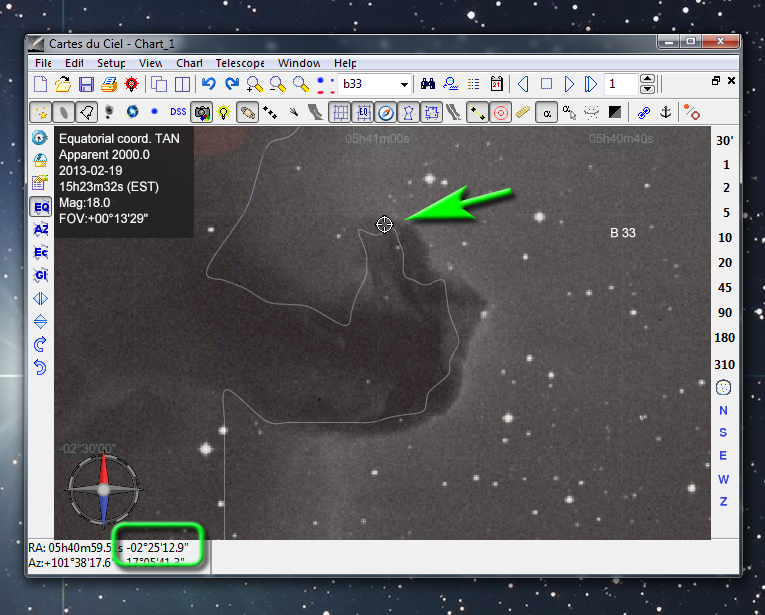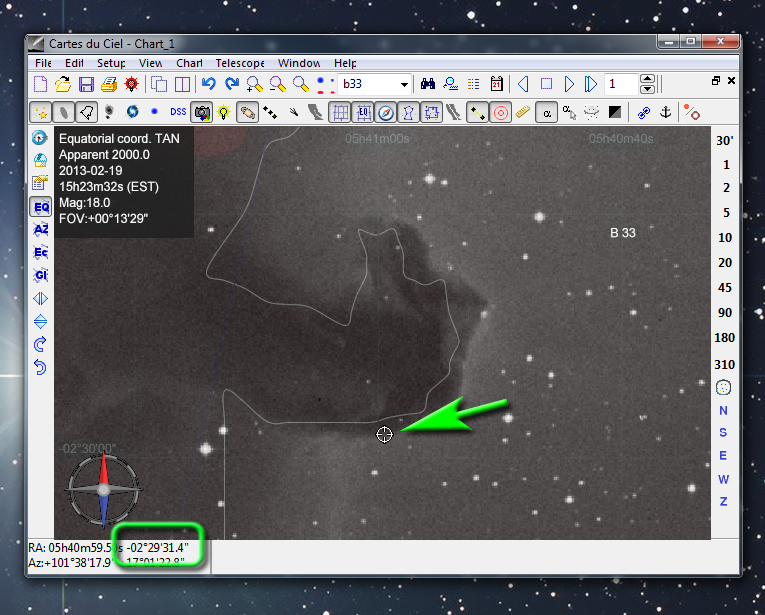APOD: The Horsehead Nebula in Infrared... (2013 Apr 22)
-
lefthip
Re: APOD: The Horsehead Nebula in Infrared... (2013 Apr 22)
Spectacular, but can we have some context? How "big" is it anyhow?
Re: APOD: The Horsehead Nebula in Infrared... (2013 Apr 22)
Please can someone answer this question:
are they three channels of infrared seen in false colors,
or is it simply red channel replaced by infrared ?
Thanks
are they three channels of infrared seen in false colors,
or is it simply red channel replaced by infrared ?
Thanks
Re: APOD: The Horsehead Nebula in Infrared... (2013 Apr 22)
The image combines data from two infrared sources mapped to blue and orange.epitalon wrote:Please can someone answer this question:
are they three channels of infrared seen in false colors,
or is it simply red channel replaced by infrared ?
Thanks
[b][i]Hubble Heritage: Fast Facts[/i][/b] wrote:
WFC3/IR F110W (YJ) (blue)
WFC3/IR F160W (H) (orange)
See also: Hubble Heritage: Original Images
Know the quiet place within your heart and touch the rainbow of possibility; be
alive to the gentle breeze of communication, and please stop being such a jerk. — Garrison Keillor
alive to the gentle breeze of communication, and please stop being such a jerk. — Garrison Keillor
Re: APOD: The Horsehead Nebula in Infrared... (2013 Apr 22)
thanks bystander
- neufer
- Vacationer at Tralfamadore
- Posts: 18805
- Joined: Mon Jan 21, 2008 1:57 pm
- Location: Alexandria, Virginia
Re: APOD: The Horsehead Nebula in Infrared... (2013 Apr 22)

. http://en.wikipedia.org/wiki/Commando_CodyBoomer12k wrote:
Oh, hey, I got promoted to Commander...GREAT!!!
:---[===] *
. http://auto.howstuffworks.com/1953-1954 ... rliner.htm
. http://asterisk.apod.com/viewtopic.php? ... 89#p197489
Art Neuendorffer
- neufer
- Vacationer at Tralfamadore
- Posts: 18805
- Joined: Mon Jan 21, 2008 1:57 pm
- Location: Alexandria, Virginia
Re: APOD: The Horsehead Nebula in Infrared... (2013 Apr 22)
About 3 light years wide.lefthip wrote:
Spectacular, but can we have some context? How "big" is it anyhow?
Art Neuendorffer
- NoelC
- Creepy Spock
- Posts: 876
- Joined: Sun Nov 20, 2005 2:30 am
- Location: South Florida, USA; I just work in (cyber)space
- Contact:
Re: APOD: The Horsehead Nebula in Infrared... (2013 Apr 22)
Excerpted from my book, Star Vistas:Markus Schwarz wrote:Can someone tell me the size of the Horsehead Nebula?
Somehow I have come up with a different size than neufer.To give you a sense of scale, the size of the horse "head" itself from the tip of the "nose" to "mane" is about 1.5 light-years, which is about 1,000 times the diameter of the orbit of Pluto around our Sun. That's one big horse!
I measured it to be 4 arc-minutes from nose to mane. If we assume it's about 1.5 thousand light-years from Earth, and is 4/60ths of a degree across, this math seems to express the width: 1500 * tan(4/60), which evaluates to about 1.7, so my 1.5 was a bit on the low side. But it still seems closer to 1.5 than 3. Did I go wrong somewhere?
-Noel
- neufer
- Vacationer at Tralfamadore
- Posts: 18805
- Joined: Mon Jan 21, 2008 1:57 pm
- Location: Alexandria, Virginia
Re: APOD: The Horsehead Nebula in Infrared... (2013 Apr 22)
Same math but I used the Wikipedia size: 8 × 6 arcmins and assumed that "nose" to "mane" was the 8 arcmins.NoelC wrote:Markus Schwarz wrote:
Can someone tell me the size of the Horsehead Nebula?Somehow I have come up with a different size than neufer.Excerpted from my book, [i]Star Vistas[/i]: wrote:To give you a sense of scale, the size of the horse "head" itself from the tip of the "nose" to "mane" is about 1.5 light-years, which is about 1,000 times the diameter of the orbit of Pluto around our Sun. That's one big horse!
I measured it to be 4 arc-minutes from nose to mane. If we assume it's about 1.5 thousand light-years from Earth, and is 4/60ths of a degree across, this math seems to express the width: 1500 * tan(4/60), which evaluates to about 1.7, so my 1.5 was a bit on the low side. But it still seems closer to 1.5 than 3. Did I go wrong somewhere?
Perhaps we should really be using "hands."
http://en.wikipedia.org/wiki/Horse wrote:
<<The height of horses is measured at the highest point of the withers, where the neck meets the back. This point is used because it is a stable point of the anatomy, unlike the head or neck, which move up and down in relation to the body of the horse.The English-speaking world measures the height of horses in hands and inches: one hand is equal to 4 inches. The height is expressed as the number of full hands, followed by a point, then the number of additional inches, and ending with the abbreviation "h" or "hh" (for "hands high"). Thus, a horse described as "15.2 h" is 15 hands plus 2 inches, for a total of 62 inches in height.>>
Art Neuendorffer
-
Gwangwook Kim
- Asternaut
- Posts: 5
- Joined: Mon Apr 22, 2013 1:43 am
- AKA: GW Kim
- Location: Seoul, Korea
- Contact:
- NoelC
- Creepy Spock
- Posts: 876
- Joined: Sun Nov 20, 2005 2:30 am
- Location: South Florida, USA; I just work in (cyber)space
- Contact:
Re: APOD: The Horsehead Nebula in Infrared... (2013 Apr 22)
An astronomer friend of mine once let on that pretty much all measurements in the cosmos are quite inexact - essentially best guesses.neufer wrote:NoelC wrote:Markus Schwarz wrote: Same math but I used the Wikipedia size: 8 × 6 arcmins and assumed that "nose" to "mane" was the 8 arcmins.
That said, I just retraced my steps. Here's what I did... Note the declination measurements for the two points I've chosen in these sky chart program screen grabs:


This time I retrieved the Digitized Sky Survey image, which the chart program overlaid for me. Prior to this I had measured to the chart outline, which as you can see is a bit smaller than the extents of the actual nebula.
Subtracting the two declination measurements above, we get 4' 18.5" difference, or roughly 4.31'.
Since the horsehead is not far from the celestial equator (about 2.5 degrees), I originally roughly equated the declination difference to the angular size of the object. In fact, the angular size of an object will be progressively larger than the declination difference for objects as we move away from the equator and closer to the pole, so let's push the actual size a bit up further to 4.31 * (90 / 87.5), or 4.43 minutes of arc.
1500 * tan(4.43 / 60) == 1.9 light-years. This is assuming the 1500 light-year distance is correct and expressing the number in 2 significant digits makes sense, but in fact one can find estimates that go lower and higher (I found more lower than higher).
So let's say a "best" guess is 2ish light years, nose to mane, or about 1300ish times the diameter of the orbit of pluto. Looked at another way, if the horsehead were displayed in an image where it was 1300 pixels wide, mostly filling a monitor screen, the space our solar system occupies (to the orbit of Pluto, to which our fastest spacecraft take years to reach) would be 1 pixel.
That's one big horse!
-Noel
- rstevenson
- Quis custodiet ipsos custodes?
- Posts: 2705
- Joined: Fri Mar 28, 2008 1:24 pm
- Location: Halifax, NS, Canada
Re: APOD: The Horsehead Nebula in Infrared... (2013 Apr 22)
Great figurin' Noel. 
Based on that, and using a 1680 px wide version of the image, I did a screen capture and blew up a star, from the "forehead" part of the image, which happened to be 2 pixels wide - which at this scale should be a little larger than the Solar System. It's a bit startling to see how small our cosy little home is compared to this nebula!
Rob
Based on that, and using a 1680 px wide version of the image, I did a screen capture and blew up a star, from the "forehead" part of the image, which happened to be 2 pixels wide - which at this scale should be a little larger than the Solar System. It's a bit startling to see how small our cosy little home is compared to this nebula!
Rob
- neufer
- Vacationer at Tralfamadore
- Posts: 18805
- Joined: Mon Jan 21, 2008 1:57 pm
- Location: Alexandria, Virginia
Re: APOD: The Horsehead Nebula in Infrared... (2013 Apr 22)
NoelC wrote:I retrieved the Digitized Sky Survey image, which the chart program overlaid for me. Prior to this I had measured to the chart outline, which as you can see is a bit smaller than the extents of the actual nebula.neufer wrote:
Same math but I used the Wikipedia size: 8 × 6 arcmins and assumed that "nose" to "mane" was the 8 arcmins.
Subtracting the two declination measurements above, we get 4' 18.5" difference, or roughly 4.31'.
Since the horsehead is not far from the celestial equator (about 2.5 degrees),
I originally roughly equated the declination difference to the angular size of the object.
Declination differences exactly equate to the angular size of the object (at the same Right ascension).
Hence: 1500 * tan(4.31 / 60) ~ 1.9 light-years
(So much for Wikipedia's 8 × 6 arcmins.)
But not as big as some believe:NoelC wrote:
So let's say a "best" guess is 2ish light years, nose to mane, or about 1300ish times the diameter of the orbit of pluto. Looked at another way, if the horsehead were displayed in an image where it was 1300 pixels wide, mostly filling a monitor screen, the space our solar system occupies (to the orbit of Pluto, to which our fastest spacecraft take years to reach) would be 1 pixel.
That's one big horse!
http://wiki.answers.com/Q/What_is_the_a ... _and_miles
Last edited by neufer on Wed Apr 24, 2013 5:09 pm, edited 1 time in total.
Art Neuendorffer
- NoelC
- Creepy Spock
- Posts: 876
- Joined: Sun Nov 20, 2005 2:30 am
- Location: South Florida, USA; I just work in (cyber)space
- Contact:
Re: APOD: The Horsehead Nebula in Infrared... (2013 Apr 22)
You're right, of course about the declination difference being the same everywhere. I had crossed up my RA and Dec when imaginin' lines in the sky...
I wus overthinkin' it. No horse sense.
-Noel
I wus overthinkin' it. No horse sense.
-Noel
- mjimih
- Science Officer
- Posts: 244
- Joined: Tue Nov 27, 2012 2:48 am
- AKA: Mark
- Location: Minnesota usa
Re: APOD: The Horsehead Nebula in Infrared... (2013 Apr 22)
Instead of boring black, it's now a beautiful red n blue translucent cosmic jellyfish.
Aliens will find Earth absolutely amazingly beautiful and fragile to behold. But if they get close enough, they'll see 7,000,000,000 of us and think "Uh oh, that's a lot for such a small planet. Wonder if we should help?"
